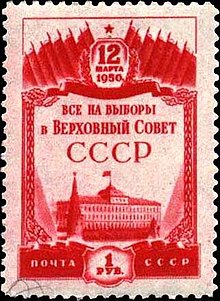
The electoral system of the Soviet Union was varying over time, being based upon Chapter XIII of the provisional Fundamental Law of 1922, articles 9 and 10 of the 1924 Constitution and Chapter XI of the 1936 Constitution, with the electoral laws enacted in conformity with those. The Constitution and laws applied to elections in all Soviets, from the Supreme Soviet of the Soviet Union, the Union republics and autonomous republics, through to regions, districts and towns. Voting was claimed to be secret and direct with universal suffrage.[1] However, in practice, between 1936 and 1989, voters could vote against candidates preselected by the Communist Party only by spoiling their ballots, or by voting against the only candidate, whereas votes for the party candidates could be cast simply by submitting a blank ballot.[2][3][4][5][6] A person would be given a ballot by a clerk, and could immediately walk to the ballot box, and while there were booths in which one could strike the candidates they voted against off the ballot, this was easy to record and was not commonly done by voters.
A 1945 decree allowed for members of the Red Army stationed outside the Soviet Union to vote for both chambers of the Supreme Soviet of the USSR (the Soviet of the Union and Soviet of Nationalities) in special 100,000-member districts. These were first enacted in the 1946 legislative elections and continued through the next decades as the Red Army continued its presence in the Eastern Bloc.[7]
- ^ Leonard Bertram Schapiro, The government and politics of the Soviet Union, Taylor & Francis, 1977, ISBN 0-09-131721-5
- ^ Nohlen, D & Stöver, P (2010) Elections in Europe: A data handbook, p1642 ISBN 978-3-8329-5609-7
- ^ Carson, George Barr (1955). Electoral Practices in the U.S.S.R. F.A. Praeger.
- ^ KOGAN, MICHAEL (2012). "SHAPING SOVIET JUSTICE: Popular responses to the election of people's courts, 1948-1954". Cahiers du Monde russe. 53 (1): 121–139. doi:10.4000/monderusse.9370. ISSN 1252-6576. JSTOR 23418027.
- ^ Getty, J. Arch (1991). "State and Society under Stalin: Constitutions and Elections in the 1930s". Slavic Review. 50 (1): 18–35. doi:10.2307/2500596. JSTOR 2500596.
- ^ Jessen, Ralph; Richter, Hedwig, eds. (2011). Voting for Hitler and Stalin: Elections Under 20th Century Dictatorships. University of Chicago Press. ISBN 978-3-593-39489-3.
- ^ The Distinctiveness of Soviet Law. Ferdinand Joseph Maria Feldbrugge, ed. Martinus Nijhoff Publishers: Dordrecht (1987): 112.